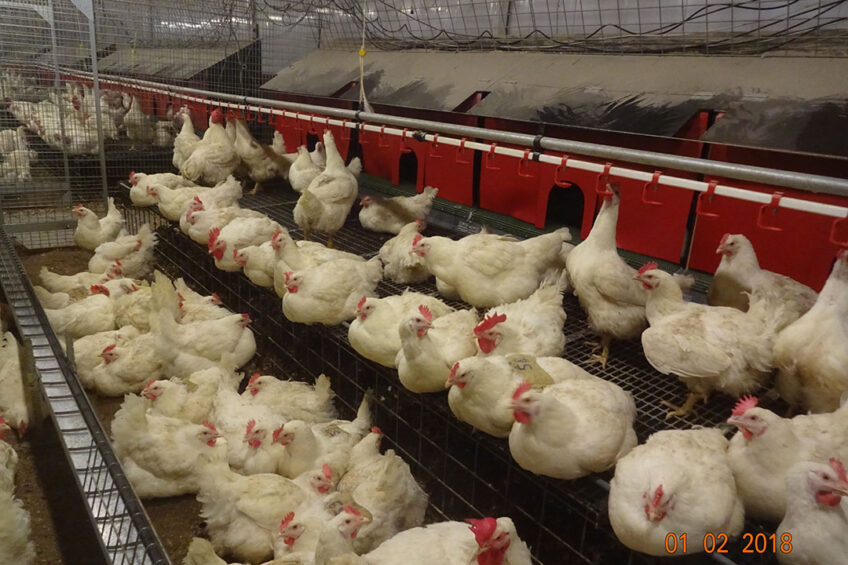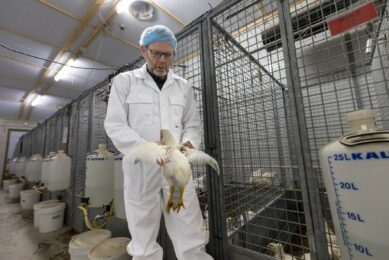Broiler breeders prefer wooden nests

Number of eggs, fertility and hatchability – as a broiler breeder operation there are many parameters to keep on top of. One extra headache is the number of floor eggs as they involve extra labour.
Optimum rearing, keeping the birds active and a raised slatted area can help prevent floor eggs, but recent research into nesting behaviour showed that the type of nest is a deciding factor.
In an existing broiler breeder house, the equipment and laying nests are what you have to work with. Only in a nightmare scenario would you go to the length of ripping equipment out and investing in new kit, despite the financial implications. However, when building a new farm or adding houses, you can go back to the basics, learn from past experience and, above all, take the opportunity to implement the latest technology and insights.
Broiler breeder behaviour
Interesting new insights have come from researcher Anne van den Oever, PhD student at the Dutch Wageningen University and researcher at the Vencomatic Group. In close cooperation with the Swiss University of Bern, she looked into the finer points of broiler breeder behaviour. “A lot of work has been done in the past on the behaviour of layers, but questions remained on the interaction between breeders and the house design. Many of these have to do with nest preference. We know that in some houses there is a problem with gregarious nesting, leading to floor eggs, full egg belts and wounded birds. Even though all the nests are the same, the birds crawl together due to genetic factors. From that, one thing led to another and we designed a new trial focusing on nesting preferences.”
Ideal conditions for the birds
The idea of Van den Oever’s research was to find out what type of laying nest would meet all criteria. Not so much the standards of the nest designer but the far more important criteria of the birds. “We took our research experience into account along with Vencomatic’s decades-long customer feedback on the main issues in actual, day-to-day farming,” says Van den Oever. “When attempting to optimise housing conditions for broiler breeders kept on commercial farms, the main question is: what does the hen prefer? Providing nests with a preferred design has benefits for the hens as well as for the producer. Plus, the welfare of the hens will likely be improved by meeting their needs which could also increase the number of eggs laid in the nests as opposed to other locations.”

According to Van den Oever, the attractiveness of nests may involve factors such as seclusion, material and microclimate. “From experience we know that less than ideal nests not only lead to floor eggs, but also relatively more visits to the nest per egg laid and shorter nesting times. A natural conclusion would be that the hens don’t feel happy on the nest.”
Study: hen preferences
To find out more about the hens’ preferences they were given a free choice of nest. “In this study, 4 nest box designs were offered in a relative preference test. We used a plastic control nest, a plastic nest with a partition to divide the nest into 2 areas offering some seclusion, a plastic nest with a ventilator underneath to create air flow inside the nest to mimic a drafty nest, and a wooden nest in which every contact surface the hen encounters is made of wood.
How to prevent floor eggs?
Besides causing serious back ache, floor eggs cut into farm profits as well. You cannot sell floor eggs as first grade eggs, so the return is lower. Read more…
A total of 6 groups of 100 hens and 9 roosters had access to these 4 nests in a randomised location between the ages of 20 to 34 weeks,” Van den Oever explains. The hens were constantly monitored with cameras inside the nests during the age periods of 24–25 weeks and 26–27 weeks. The images were analysed for behaviour, including general activity, nest inspections, nest visits and social interaction.
A strong preference for wooden nests
Based on the assumption that a hen doesn’t have a preference, every nest design in the study should account for 25% of the eggs laid. Taking into account the unattractive ventilated (drafty) nest, 33% per nest type would still be expected. But these average statistics can only be applied if we were to see hens as egg laying machines.
Van den Oever: “And they are far from that; they are very picky indeed. From our study we could conclude that there is a strong preference among broiler breeder hens for wooden nests rather than plastic nests. No less than 70% of the eggs ended up in the wooden nest and we saw more settled nesting behaviour in the wooden nests, too.”
Hens’ second choice
Only 15% of the hens chose the plastic control nest, 10% the nest with the partition and 5% the ventilator nest. With only 1 in 4 nests being wooden, the hens’ preference led to crowding, causing piling and aggressive behaviour in the wooden nest. However, this preference was so strong that the hens were willing to accept this environment as they continually returned to the nest day after day.”

To find out what would be the hens second option, the wooden nests were closed off at some point in the study. Van den Oever comments: “Closing off the wooden nest led to a new nest choice which was the result of an interaction between nest design and proximity to the closed wooden nest. The control nest was still preferred over the other two plastic designs, although the neighbouring nests closest to the wooden nest were preferred to the non-neighbouring nests.”
Full circle
The study shows that hens have a strong preference for wooden nests. Van den Oever: “The material used for nests is an important factor in suitability and should therefore be taken into account when designing and choosing nests. Our trial was designed following European housing standards but we expect that it will also be applicable in other parts of the world.”
The best fit for every farm
That said, the conclusion of the study and the clear preference for wooden nests has quite some implications. Van den Oever’s sponsor, Vencomatic, for many years known for its high quality plastic nests, took the results to heart. As a result of Van den Oever’s work, the company acquired Van Gent, world famous for its wooden nests, so it can offer the best fit for every farm. In combination with optimum management and rearing, wooden nests can reduce the number of floor eggs to a minimum.
Join 31,000+ subscribers
Subscribe to our newsletter to stay updated about all the need-to-know content in the poultry sector, three times a week. Beheer
Beheer








 WP Admin
WP Admin  Bewerk bericht
Bewerk bericht